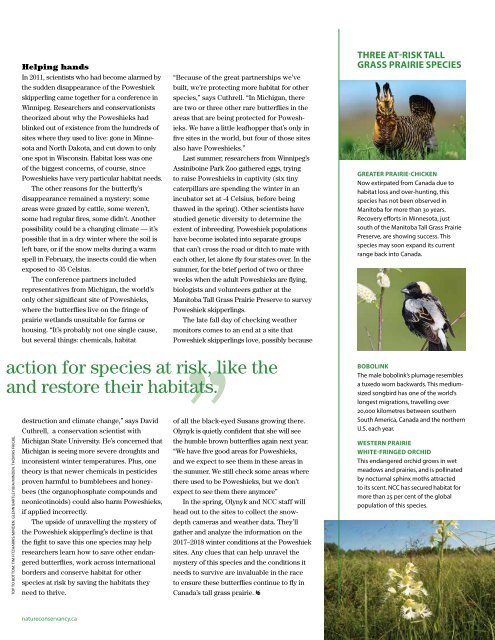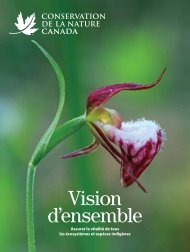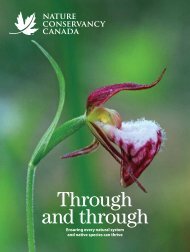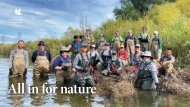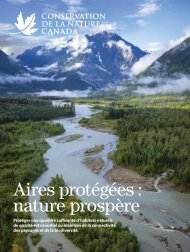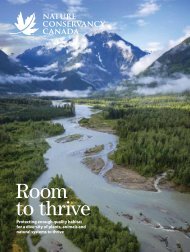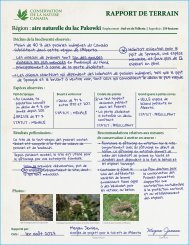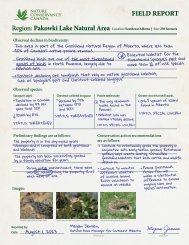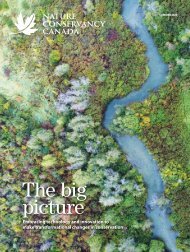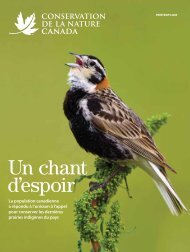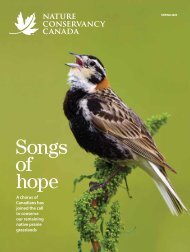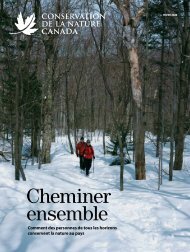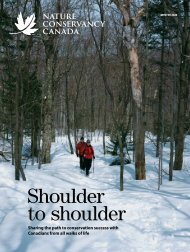Spring 2018 NCC Magazine
Create successful ePaper yourself
Turn your PDF publications into a flip-book with our unique Google optimized e-Paper software.
Helping hands<br />
In 2011, scientists who had become alarmed by<br />
the sudden disappearance of the Poweshiek<br />
skipperling came together for a conference in<br />
Winnipeg. Researchers and conservationists<br />
theorized about why the Poweshieks had<br />
blinked out of existence from the hundreds of<br />
sites where they used to live: gone in Minnesota<br />
and North Dakota, and cut down to only<br />
one spot in Wisconsin. Habitat loss was one<br />
of the biggest concerns, of course, since<br />
Poweshieks have very particular habitat needs.<br />
The other reasons for the butterfly’s<br />
disappearance remained a mystery: some<br />
areas were grazed by cattle, some weren’t,<br />
some had regular fires, some didn’t. Another<br />
possibility could be a changing climate — it’s<br />
possible that in a dry winter where the soil is<br />
left bare, or if the snow melts during a warm<br />
spell in February, the insects could die when<br />
exposed to -35 Celsius.<br />
The conference partners included<br />
representatives from Michigan, the world’s<br />
only other significant site of Poweshieks,<br />
where the butterflies live on the fringe of<br />
prairie wetlands unsuitable for farms or<br />
housing. “It’s probably not one single cause,<br />
but several things: chemicals, habitat<br />
“Because of the great partnerships we’ve<br />
built, we’re protecting more habitat for other<br />
species,” says Cuthrell. “In Michigan, there<br />
are two or three other rare butterflies in the<br />
areas that are being protected for Poweshieks.<br />
We have a little leafhopper that’s only in<br />
five sites in the world, but four of those sites<br />
also have Poweshieks.”<br />
Last summer, researchers from Winnipeg’s<br />
Assiniboine Park Zoo gathered eggs, trying<br />
to raise Poweshieks in captivity (six tiny<br />
caterpillars are spending the winter in an<br />
incubator set at -4 Celsius, before being<br />
thawed in the spring). Other scientists have<br />
studied genetic diversity to determine the<br />
extent of inbreeding. Poweshiek populations<br />
have become isolated into separate groups<br />
that can’t cross the road or ditch to mate with<br />
each other, let alone fly four states over. In the<br />
summer, for the brief period of two or three<br />
weeks when the adult Poweshieks are flying,<br />
biologists and volunteers gather at the<br />
Manitoba Tall Grass Prairie Preserve to survey<br />
Poweshiek skipperlings.<br />
The late fall day of checking weather<br />
monitors comes to an end at a site that<br />
Poweshiek skipperlings love, possibly because<br />
THREE AT-RISK TALL<br />
GRASS PRAIRIE SPECIES<br />
GREATER PRAIRIE-CHICKEN<br />
Now extirpated from Canada due to<br />
habitat loss and over-hunting, this<br />
species has not been observed in<br />
Manitoba for more than 30 years.<br />
Recovery efforts in Minnesota, just<br />
south of the Manitoba Tall Grass Prairie<br />
Preserve, are showing success. This<br />
species may soon expand its current<br />
range back into Canada.<br />
action for species at risk, like the<br />
and restore their habitats.<br />
TOP TO BOTTOM: TIM FITZHARRIS/MINDEN. GLENN BARTLEY/BIA/MINDEN. THOMAS FRICKE.<br />
destruction and climate change,” says David<br />
Cuthrell, a conservation scientist with<br />
Michigan State University. He’s concerned that<br />
Michigan is seeing more severe droughts and<br />
inconsistent winter temperatures. Plus, one<br />
theory is that newer chemicals in pesticides<br />
proven harmful to bumblebees and honeybees<br />
(the organophosphate compounds and<br />
neonicotinoids) could also harm Poweshieks,<br />
if applied incorrectly.<br />
The upside of unravelling the mystery of<br />
the Poweshiek skipperling’s decline is that<br />
the fight to save this one species may help<br />
researchers learn how to save other endangered<br />
butterflies, work across international<br />
borders and conserve habitat for other<br />
species at risk by saving the habitats they<br />
need to thrive.<br />
of all the black-eyed Susans growing there.<br />
Olynyk is quietly confident that she will see<br />
the humble brown butterflies again next year.<br />
“We have five good areas for Poweshieks,<br />
and we expect to see them in these areas in<br />
the summer. We still check some areas where<br />
there used to be Poweshieks, but we don’t<br />
expect to see them there anymore”<br />
In the spring, Olynyk and <strong>NCC</strong> staff will<br />
head out to the sites to collect the snowdepth<br />
cameras and weather data. They’ll<br />
gather and analyze the information on the<br />
2017–<strong>2018</strong> winter conditions at the Poweshiek<br />
sites. Any clues that can help unravel the<br />
mystery of this species and the conditions it<br />
needs to survive are invaluable in the race<br />
to ensure these butterflies continue to fly in<br />
Canada’s tall grass prairie.1<br />
BOBOLINK<br />
The male bobolink’s plumage resembles<br />
a tuxedo worn backwards. This mediumsized<br />
songbird has one of the world’s<br />
longest migrations, travelling over<br />
20,000 kilometres between southern<br />
South America, Canada and the northern<br />
U.S. each year.<br />
WESTERN PRAIRIE<br />
WHITE-FRINGED ORCHID<br />
This endangered orchid grows in wet<br />
meadows and prairies, and is pollinated<br />
by nocturnal sphinx moths attracted<br />
to its scent. <strong>NCC</strong> has secured habitat for<br />
more than 25 per cent of the global<br />
population of this species.<br />
natureconservancy.ca<br />
SPRING <strong>2018</strong> 11


